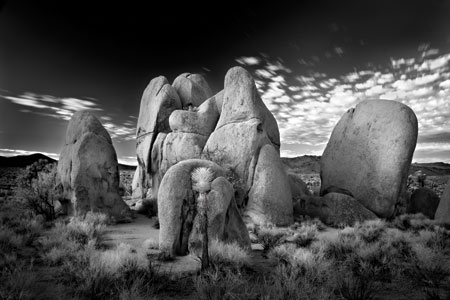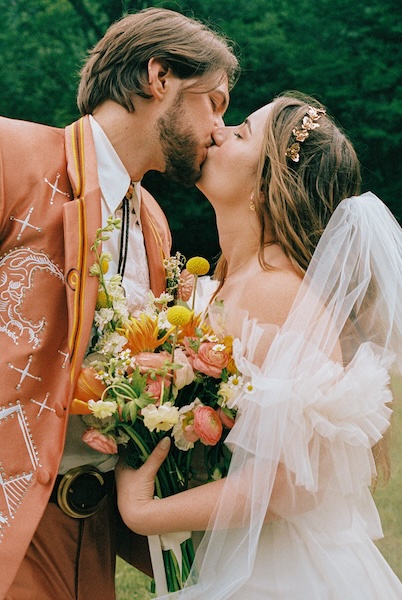Mitch Dobrowner had his, as he describes it, Woody Allen moment at Photo LA. In Allen’s movie Annie Hall, upon hearing a pseudo-intellectual discuss filmmakers, Allen breaks the fourth wall and talks to the audience directly. While Dobrowner’s work was being displayed at Photo LA, he overheard a couple discussing one of his photographs and describing the Photoshop work involved in the final composite.
Dobrowner listened with interest and then politely stepped in to set the record straight. He told them that everything they were saying was completely wrong. They looked at him with bewilderment until they noticed his name tag, realizing he was the artist.
This couple wasn’t being snide. There is something unique and intangible about Dobrowner’s landscape images that beg the viewer to question how much of his artistry depends on Photoshop. And you also wonder if such a convergence of light and form has actually ever existed.
But, for the record, Dobrowner is a purist and remains true to the latent image, which refers back to the days of the darkroom where an image, once exposed, was latent. It took proper development and skillful printing to turn a latent image into art. So, though he works digitally, Dobrowner follows a more traditional paradigm. “I come from a traditional film/wet darkroom background and only see imagery in black and white,” he says.
“Color photography seems too realistic to me. It’s great for some, but just not for me. With black and white, I can interpret reality the way I happen to see and feel.” He continues, “My wife, who is a wonderful designer and painter, says I’m colorblind. But I’m not.”
From Start to Finish
Over a two-hour lunch, Dobrowner discusses how he creates these unique images that keep his viewers returning for second or third looks. These hard-to-describe qualities of his work are much more tangible when he details how an image is made from start to finish. His extensive preparations before embarking on a shoot make it clear that he’s not aiming his camera wildly, but instead making careful calculations. Dobrowner shares, “Usually I see an image in my mind before I head out.
I research road systems, weather models, the times the sun rises and sets. And when I get out there I spend time in the environment understanding and connecting with it. I talk to it in my own way.” He continues, “Many of the landscapes I photograph are ancient structures… they have seen and witnessed much. I want my images of them to speak for themselves.”
One such ancient structure is Shiprock (below), a strange rock outcropping in New Mexico that rises from an otherwise utterly flat plateau. “I had seen images of Shiprock before, but never the image I had in my mind. Though I hadn’t seen the formation in person, this rock moved me. I had to see it, so I grabbed my family and traveled 800 miles to the Four Corners.” (The Four Corners is the only place in the United States where four states—Arizona, New Mexico, Utah and Colorado—come together at one place).
With his family in tow, Dobrowner arrived in Farmington, NM at the end of December, in bitterly cold temperatures. Over the course of a week, he woke up at “ungodly hours,” to drive long distances to arrive at first light, leaving at sundown to catch the last light. Add nasty weather and frostbitten toes to the mix and you’ll get a sense of what Dobrowner puts himself through to capture these elusive images. But he’s ultimately rewarded with exactly what he wants. “The light was awesome: moody and atmospheric. I loved it. Nothing for me is better then standing out in the middle of the desert alone, wind and cold in my face in front of these amazing stone structures.”
The ride from Farmington to Shiprock didn’t prove any easier, as it was snowing then raining, with the temps on his truck registering between 0–12 degrees Fahrenheit. Dragging himself out of bed at 4:30 a.m., Dobrowner’s resolve began to fade. He says, “I remember thinking I was nuts… I kept thinking, ‘Why are you going out again when you could have stayed with your family in a warm bed? You’re an idiot. You’re not going to get anything.’ ” But his resolve returned. “I felt driven as I wanted to capture the image I drove 800 miles from California to get.”
When he finally arrived, Shiprock was hidden behind a wall of clouds.
Then he stepped out of his truck with camera and tripod in hand and promptly sank ankle deep into cold mud. But this didn’t deter him. He says, “For the next three hours I sat in front of Shiprock, not a soul around; and I felt humbled. I felt connected. It’s these moments that I live for. Experiencing moments like that is what keeps me alive.”
Twenty-year Hiatus
Dobrowner’s first experience with photography came at a time when he was unsure of what direction to take as a technology major in college. He was living in Long Island, NY at the time and his father, knowing Dobrowner needed some direction, handed him his first camera. He took to the camera instantly. Before long, he discovered the work of Ansel Adams and Minor White and suddenly his direction was certain.
Later that year he began assisting for photographers Pete Turner and Hashi in New York City. Through these connections, he earned a small grant from Canon and used it to travel across the country for four years focusing primarily on his photography.
Eventually he settled in California, got married and started a family. His priorities shifted and he left photography behind for 20 years, until several years ago when a friend, a photo enthusiast, invited Dobrowner to join him on a trip to Death Valley. Dobrowner was smitten again, only now propelling his photography forward into overdrive; almost, it seems, to make up for lost time.
Unsure of his printing abilities, he contacted a local gallery and offered to pay them a fee for some constructive feedback. He left that meeting with an offer to have a solo show in the gallery. Then his work was profiled in LensWork in March 2007. Soon after the John Cleary Gallery in Houston contacted him for representation and a solo exhibit.
Dobrowner had another solo exhibit at the Kopeikin Gallery in Los Angeles, showing his Storm series. “Photographing a storm is totally a rush,” Dobrowner says. “I’m never scared, only excited. It’s something between shooting a landscape and shooting a sports event. Usually I don’t know exactly what I’m walking into when I’m about to step out of the vehicle, so I’ve learned to stay focused and be prepared for anything.
Sometimes all hell is breaking loose and I find myself having to make quick decisions about composition, exposure, shutter speed and focus, always keeping conscious of what’s going on around me, whether there is lightning, hail or a tornado. I try to keep the rain off the front of the lens so I don’t blow a shot.
“Sometimes I find myself standing in a field miles from a storm cell, out of the rain and can focus quietly and enjoy the scenery; but that’s rare. All I know is that these storms are amazing sights to witness and I’m happy to be there—shot or no shot; it’s watching Mother Nature at her finest. All I want is for any images I produce to do justice to these events.” He chuckles, “Before I went out on my first storm trip,w my wife made me write my will. I had to do it anyway.”
Down to the Details
Dobrowner’s primary camera is a Canon EOS 5D Mark II. Prior to that he used Sony DSC-R1 cameras for several years. He believes the camera was ahead of its time in several ways. First of all, Sony eliminated the mirror box. This enabled them to move the back of the lens (a Zeiss) closer to the sensor plane, thus minimizing edge distortion. Second, they provided a Live View capability. When I heard this, I doubted that I heard correctly. But, yes, Dobrowner was saying he viewed the image on the LCD, before he took the photo. That would be heresy to many professional photographers, but it makes perfect sense for Dobrowner.
Since Dobrowner wants his images to be as close as possible to the end product, he prefers not to rely on Photoshop. He comments, “Anything you do in Photoshop changes and degrades the image data.” So, he uses colored filters in the field, and sets his display to black-and-white mode. In doing so, he shoots black and white and the display shows him the end result.
To someone who might be accustomed to using Photoshop for black-and-white conversions, this methodology may seem too constraining. But when you consider that Dobrowner usually goes into the field with a camera capable of shooting infrared photography, as well as a regular unconverted camera, you can see the true advantages. Using Live View shows him what the infrared image looks like immediately. If he adds a filter, he can see exactly how it affects the image, since he is viewing in black-and-white mode. He’s had quite a bit of experience with infrared photography from his film days when he used to shoot with infrared color and infrared black-and-white film.
Dobrowner says that the digital sensor can record wavelengths beyond what the human eye can see. “We can see between about 400–700 nanometers, whereas a digital sensor can see roughly between 350–1000 nanometers. Manufacturers place an infrared blocking filter in front of the sensor to block the wavelengths below and beyond the visible spectrum we see so that color imagery looks accurate.” He continues, “But since I’m not interested in color I can use either the full spectrum or part of it based on the subject matter I’m photographing and the way I decide to filter it. It’s the same manner in which I used to shoot with black-and-white film. I’m just treating the sensor similar to the way I treated the film plane in a traditional-view camera.
“My hope now is that a camera manufacturer would remove the Bayer layers glued onto the tops of the camera’s sensor and create a true black-and-white digital camera. But, putting all this techno-talk aside, what I really want is that my images speak for themselves when people look at them. That’s all the really matters to me.”
View Dobrowner’s work at www.mitchdobrowner.com.
Writer/photographer Larry Brownstein is based in Los Angeles, CA. He has authored several photography books, is represented by Getty Images, Alamy and California Stock Photo and has a growing wedding and portrait photography business. His Web site is www.larrybrownstein.com. His blog is https://larrybrownstein.bigfolioblog.com.





